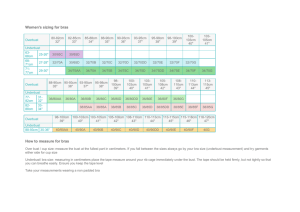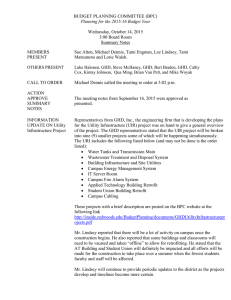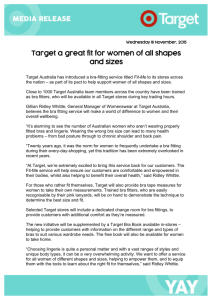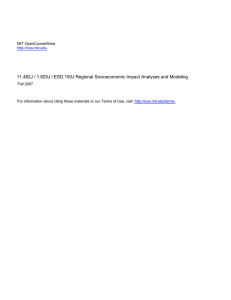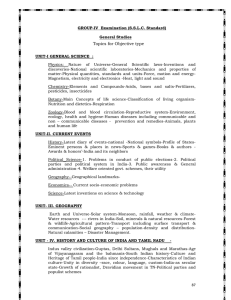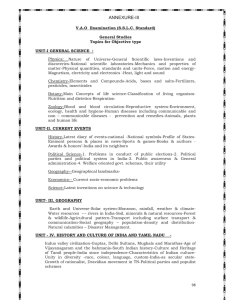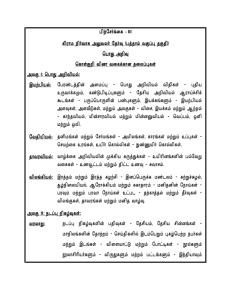COMBINED CIVIL SERVICES – II G r o
advertisement
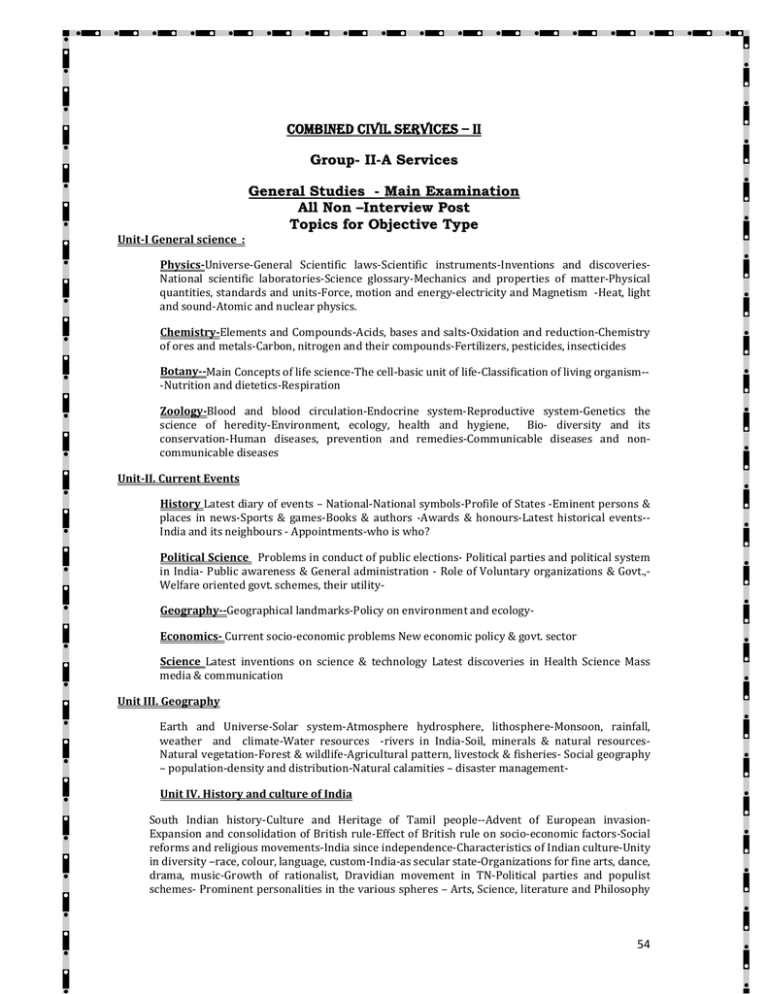
COMBINED CIVIL SERVICES – II Group- II-A Services General Studies - Main Examination All Non –Interview Post Topics for Objective Type Unit­I General science : Physics­Universe‐General Scientific laws‐Scientific instruments‐Inventions and discoveries‐ National scientific laboratories‐Science glossary‐Mechanics and properties of matter‐Physical quantities, standards and units‐Force, motion and energy‐electricity and Magnetism ‐Heat, light and sound‐Atomic and nuclear physics. Chemistry­Elements and Compounds‐Acids, bases and salts‐Oxidation and reduction‐Chemistry of ores and metals‐Carbon, nitrogen and their compounds‐Fertilizers, pesticides, insecticides Botany­­Main Concepts of life science‐The cell‐basic unit of life‐Classification of living organism‐‐ ‐Nutrition and dietetics‐Respiration Zoology­Blood and blood circulation‐Endocrine system‐Reproductive system‐Genetics the science of heredity‐Environment, ecology, health and hygiene, Bio‐ diversity and its conservation‐Human diseases, prevention and remedies‐Communicable diseases and non‐ communicable diseases Unit­II. Current Events History Latest diary of events – National‐National symbols‐Profile of States ‐Eminent persons & places in news‐Sports & games‐Books & authors ‐Awards & honours‐Latest historical events‐‐ India and its neighbours ‐ Appointments‐who is who? Political Science Problems in conduct of public elections‐ Political parties and political system in India‐ Public awareness & General administration ‐ Role of Voluntary organizations & Govt.,‐ Welfare oriented govt. schemes, their utility‐ Geography­­Geographical landmarks‐Policy on environment and ecology‐ Economics­ Current socio‐economic problems New economic policy & govt. sector Science Latest inventions on science & technology Latest discoveries in Health Science Mass media & communication Unit III. Geography Earth and Universe‐Solar system‐Atmosphere hydrosphere, lithosphere‐Monsoon, rainfall, weather and climate‐Water resources ‐rivers in India‐Soil, minerals & natural resources‐ Natural vegetation‐Forest & wildlife‐Agricultural pattern, livestock & fisheries‐ Social geography – population‐density and distribution‐Natural calamities – disaster management‐ Unit IV. History and culture of India South Indian history‐Culture and Heritage of Tamil people‐‐Advent of European invasion‐ Expansion and consolidation of British rule‐Effect of British rule on socio‐economic factors‐Social reforms and religious movements‐India since independence‐Characteristics of Indian culture‐Unity in diversity –race, colour, language, custom‐India‐as secular state‐Organizations for fine arts, dance, drama, music‐Growth of rationalist, Dravidian movement in TN‐Political parties and populist schemes‐ Prominent personalities in the various spheres – Arts, Science, literature and Philosophy 54 – Mother Teresa, Swami Vivekananda, Pandit Ravishankar , M.S.Subbulakshmi, Rukmani Arundel and J.Krishnamoorthy etc. UNIT­V. INDIAN POLITY Constitution of India‐ Preamble to the constitution‐ Salient features of constitution‐ Union, State and territory ‐ Fundamental rights‐ Fundamental duties‐ Human rights charter‐ Union legislature – Parliament‐ State executive‐. State Legislature – assembly‐ Status of Jammu & Kashmir‐. Local government – panchayat raj – Tamil Nadu‐ Judiciary in India – Rule of law/Due process of law‐ Indian federalism – center – state relations‐ Emergency provisions‐ Elections ‐ Election Commission Union and State‐ Amendments to constitution‐ Schedules to constitution‐ Administrative reforms & tribunals‐ Corruption in public life‐ Anti‐corruption measures – Central Vigilance Commission, lok‐adalats, Ombudsman, Comptroller and Auditor General of India‐ Right to information ‐ Central and State Commission‐ Empowerment of women. UNIT­ VI. INDIAN ECONOMY Nature of Indian economy‐ Five‐year plan models‐an assessment‐Land reforms & agriculture‐ Application of science in agriculture‐Industrial growth‐Role of public sector & disinvestment‐ Development of infrastructure‐ National income Rural welfare oriented programmes‐ Social sector problems – population, education, health, employment, poverty‐ HRD – sustainable economic growth‐ Economic trends in Tamil Nadu ‐ Energy Different sources and development‐ Finance Commission ‐ Planning Commission‐ National Development Council UNIT ­ VI. INDIAN NATIONAL MOVEMENT Early uprising against British rule‐1857 Revolt‐ Indian National Congress‐Emergence of national leaders‐Gandhi, Nehru, Tagore, Netaji‐Growth of militant movements ‐Communalism led to partition‐Role of Tamil Nadu in freedom struggle ‐ Rajaji, VOC, Periyar, Bharathiar& Others‐Birth of political parties /political system in India since independence— UNIT­ VII. APTITUDE & MENTAL ABILITY TESTS Conversion of information to data‐‐Collection, compilation and presentation of data Tables, graphs, diagrams‐Analytical interpretation of data ‐Simplification‐Percentage‐Highest Common Factor (HCF)‐Lowest Common Multiple (LCM)‐Ratio and Proportion‐Simple interest‐Compound interest‐Area‐Volume‐Time and Work Decision making and problem solving‐Logical Reasoning‐ Puzzles‐Dice‐Visual Reasoning‐Alpha numeric Reasoning‐Number Series‐ Logical Number/Alphabetical/Diagrammatic Sequences …. 55 ghlj;jpl;lk; bghJj; jkpH; (bfhs;Fwptifj; njh;tpw;F) v!;/v!;/vy;/rp/ juk; gFjp ? (m) [ ,yf;fzk; 1/ bghUj;Jjy;: ? bghUj;jkhd bghUisj; njh;t[ bra;jy;; (ii) g[fH; bgw;w E}y; E}yhrphpah; 2/ bjhlUk; bjhlh;g[k; mwpjy; (i) ,j;bjhluhy; Fwpf;fg;bgWk; rhd;nwhh; (ii) milbkhHpahy; Fwpf;fg;bgWk; E}y; 3/ gphpj;bjGJf 4/ vjph;r;brhy;iy vLj;bjGJjy; 5/ bghUe;jhr; brhy;iyf; fz;lwpjy; ;6/ gpiH jpUj;jk; (i) re;jpg;gpiHia ePf;Fjy; (ii) xUik gd;ik -gpiHfis ePf;Fjy; kug[g; gpiHfs;. tGt[r; brhw;fis ePf;Fjy; - gpwbkhHpr; brhw;fis ePf;Fjy; 7/ M’;fpyr; brhy;Yf;F neuhd jkpH;r; brhy;iy mwpjy; 8/ xyp ntWghlwpe;J rhpahd bghUisawpjy; 9/ XbuGj;J xUbkhHp chpa bghUisf; fz;lwpjy; 10/ nth;r;brhy;iyj; njh;t[ bra;jy; 11/nth;r;brhy;iyf; bfhLj;J -–tpidKw;W. tpidbar;rk;. tpidahyiza[k; bgah;. bjhHpw; bgaiu - cUthf;fy; 12/ mfu thpirg;go brhw;fisr; rPh; bra;jy; 13/ brhw;fis xG’;FgLj;jp brhw;bwhluhf;Fjy; 14/ bgah;r;brhy;ypd; tifawpjy; 15/ ,yf;fzf; Fwpg;gwpjy; 16/ tpilf;nfw;w tpdhitj; njh;e;bjLj;jy; 17/ vt;tif thf;fpak; vdf; fz;blGJjy; 18/ jd;tpid. gpwtpid. bra;tpid. brag;ghl;L tpid thf;fpa’;fisf; fz;blGJjy; 19/ ctikahy; tpsf;fg;bgWk; bghUj;jkhd bghUisj; njh;e;bjGJjy; 20/ vJif. nkhid. ,iag[ ,tw;Ws; VnjDk; xd;iwj; njh;e;bjGJjy; gFjp ? (M) ,yf;fpak; 56 ; 1/jpUf;Fws; bjhlh;ghd bra;jpfs;. nkw;nfhs;fs; bjhliu epug;g[jy; (gj;bjhd;gJ mjpfhuk; kl;Lk;) md;g[?gz;g[?fy;tp?nfs;tp?mwpt[?mlf;fk;. xGf;fk;. bghiw. el;g[. tha;ik. fhyk;. typ. Xg;g[utwpjy;. bra;ed;wp. rhd;whz;ik. bghpahiuj;Jizf;nfhly;. bghUs;bray;tif. tpidj;jpl;gk;. ,dpait Twy;/ 2/ mwE}y;fs; ehyoahh;. ehd;kzpf;foif. gHbkhHpehD}W. KJbkhHpf;fh”;rp. jphpfLfk;. ,d;dh ehw;gJ. ,dpait ehw;gJ. rpWg”;rK:yk;. Vyhjp. Xsitahh; ghly;fs; bjhlh;ghd bra;jpfs;. gjpbdz;fPH;f;fzf;F E}y;fspy; gpw bra;jpfs;/ 3/ fk;guhkhazk; ? bjhlh;ghd bra;jpfs; nkw;nfhs;fs;. gh tif. rpwe;j bjhlh;fs;/ 4/ g[wehD}W ? mfehDW. ew;wpiz. FWe;bjhif. I’;FWE}W. fypj;bjhif bjhlh;ghd bra;jpfs;. nkw;nfhs;fs; motiuaiw. vl;Lj;bjhif. gj;Jg;ghl;L E}y;fspy; cs;s gpw bra;jpfs;/ 5/ rpyg;gjpfhuk;?kzpnkfiy?bjhlh;ghd bra;jpfs;. nkw;nfhs;fs;;. rpwe;j bjhlh;fs; cl;gphpt[fs; kw;Wk; Ik;bgUk;?I”;rpW’; fhg;gpa’;fs; bjhlh;ghd bra;jpfs;/ 6/ bghpag[uhzk; ? ehyhapu jpt;tpag;gpuge;jk; ? jpUtpisahlw; g[uhzk; ? njk;ghtzp ? rPwhg;g[uhzk; bjhlh;ghd bra;jpfs;/ 7/ rpw;wpyf;fpa’;fs; jpUf;Fw;whyf;Fwt”;rp ? fyp’;fj;Jg;guzp ? Kj;bjhs;shapuk;. jkpH;tpL J}J ? ee;jpf;fyk;gfk;. tpf;fpuknrhHd; cyh. Kf;Tlw;gs;S. fhtor;rpe;J. jpUnt’;flj;je;jhjp. Kj;Jf;FkhuRthkp gps;isj; jkpH;. bgj;jynfk; Fwt”;rp. mHfh; fps;istpLJ}J. ,uh$uh$d; nrhHd; cyh bjhlh;ghd bra;jpfs;/ 8/ kndhd;kzpak; ? gh”;rhyp rgjk; ? Fapy; ghl;L ? ,ul;Lw bkhHpjy;; (fhsnkfg;g[yth; ?mHfpa brhf;fehjh; bjhlh;ghd bra;jpfs);; 9/ ehl;Lg;g[wg;ghl;L ? rpj;jh; ghly;fs; bjhlh;ghd bra;jpfs;/ 10/rka Kd;ndhofs; mg;gh;. rk;ge;jh;. Re;juh;. khzpf;fthrfh;. jpUK:yh;. Fynrfu MH;;thh;. Mz;lhs;. rPj;jiyr; rhj;jdhh;. vr;/V/fpUc&;z gps;is. ckWg;g[yth; bjhlh;ghd bra;jpfs;. nkw;nfhs;fs;. rpwg;g[g; bgah;fs;/ 57 gFjp ?,? jkpH; mwp”h;fSk; jkpH;j; bjhz;Lk; 1/ ghujpahh;. ghujpjhrd;. ehkf;fy; ftp”h;. ftpkzp njrpf tpehafk; gps;is bjhlh;ghd bra;jpfs;. rpwe;j bjhlh;fs;. r[pwg;g[g; bgah;fs;/ 2/ kug[f;ftpij ? Koaurd;. thzpjhrd;. Rujh. fz;zjhrd;. cLkiyehuhazftp. gl;Lf;nfhl;il fy;ahzRe;juk;. kUjfhrp bjhlh;ghd bra;jpfs;. milbkhHpbgah;fs;/ 3/ g[Jf; ftpij ? e/gpr;rK:h;j;jp. rp/R/bry;yg;gh. jUK rptuhK. gRta;ah. ,uh/kPdhl;rp. rp/kzp. rpw;gp. K/nkj;jh. <nuhL jkpHd;gd;. mg;Jy;uFkhd;. fyhg;hpah. fy;ahz;$p. “hdf; Tj;jd;. njtnjtd;. rhiy ,se;jpiuad.; rhypdp ,se;jpiuad;. Mye;J}h; nkhfdu’;fd; ? bjhlh;ghd bra;jpfs;. nkw;nfhs;fs;. rpwg;g[j; bjhlh;fs; kw;Wk; vGjpa E}y;fs;/ 4/ jkpHpy; foj ,yf;fpak; ? ehl;Fwpg;g[/ neU ? fhe;jp ? K/t/ ? mz;zh ? Mde;ju’;fk; gp;s;is ehl;Fwpg;g[ bjhlh;ghd bra;jpfs;/ 5/ ehlff;fiy ? ,irf;fiy bjhlh;ghd bra;jpfs; 6/ jkpHpy; rpWfijfs; jiyg;g[ ? Mrphpah; ? bghUj;Jjy; 7/ fiyfs; ? rpw;gk; ? Xtpak; ? ngr;R ? jpiug;glf;fiy bjhlh;ghd bra;jpfs; 8/ jkpHpd; bjhd;ik ? jkpH; bkhHpapd; rpwg;g[. jpuhtpl bkhHpfs; bjhlh;ghd bra;jpfs; 9/ ciueil ? kiwkiyaofs;. ghpjpkhw;fiy”h;. e/K/nt’;flrhkp ehl;lhh;. uh/gp/ nrJg; gps;is. jpU/tp/f/. itahg[hpg;gps;is ? bkhHp eil bjhlh;ghd bra;jpfs;/ 10/ c/nt/rhkpehj Iah;. bj/bgh/kPdhl;rp Re;judhh;. rp/,yf;Ftdhh; ? jkpH;g;gzp bjhlh;ghd bra;jpfs; 11/ njtneag;ghthzh; ? mfuKjyp. ghtynuW bgU”; rpj;jpudhh;. jkpH;j;bjhz;L bjhlh;ghd bra;jpfs; 12/ $p/a[/nghg; ? tPukhKdpth; jkpH;j;bjhz;L rpwg;g[j; bjhlh;fs; 13/ bghpahh; ? mz;zh ? Kj;Juhkyp’;fj; njth; ? mk;ngj;fh; ? fhkuhrh; ? rKjhaj; bjhz;L/ 14/ jkpHfk; ? CUk; ngUk;. njhw;wk; khw;wk; gw;wpa bra;jpfs; 58 15/ cyfshtpa jkpHh;fs; rpwg;g[k; ? bgUika[k; ? jkpH;g; gzpa[k; 16/ jkpH;bkhHpapy; mwptpay; rpe;jidfs; bjhlh;ghd bra;jpfs; 17/ jkpH; kfsphpd; rpwg;g[ ? md;dp bgrz;l; mk;ikahh;. K:tY}h; uhkhkph;jj;jk;khs;;. lhf;lh;/Kj;Jyl;Rkp bul;o/ tpLjiyg; nghuhl;lj;jpy; kfsph; g’;F (jpy;iyaho ts;spak;ik. uhzp k’;fk;khs;) 18/ jkpHh; tzpfk; ? bjhy;ypay; Ma;t[fs; ? flw; gaz’;fs;; ? bjhlh;ghd bra;jpfs; 19/ cznt kUe;J ? neha; jPh;f;Fk; K:ypiffs; bjhlh;ghd bra;jpfs; 20/ rkag; bghJik czh;j;jpa jha[khdth;. ,uhkyp’;f mofshh;. jpU/tp/ fy;ahz Re;judhh; bjhlh;ghd bra;jpfs; ? nkw;nfhs;fs;. 59 SYLLABUS – GENERAL ENGLISH S.S.L.C. Standard (Objective Type) Grammar PART A 1. Match the following words and Phrases given in Column A with their meanings in Column B. 2.Choose the correct ‘Synonyms’ for the underlined word from the options given 3. Choose the correct ‘Antonyms’ for the underlined word from the options given 4. Select the correct word (Prefix, Suffix) 5. Fill in the blanks with suitable Article 6. Fill in the blanks with suitable Preposition 7. Select the correct Question Tag 8. Select the correct Tense 9. Select the correct Voice 10. Fill in the blanks (Infinitive, Gerund, Participle) 11. Identify the sentence pattern of the following sentence (Subject, Verb, Object….) Blanks with correct ‘Homophones’ 12. Find out the Error (Articles, Prepositions, Noun, Verb, Adjective, Adverb) 13. Comprehension 14. Select the correct sentence 15. Find out the odd words (Verb, Noun, Adjective, Adverb) 16. Select the correct Plural forms 17. Identify the sentence (Simple, Compound, Complex Sentense) 18. Identify the correct Degree. 19.Form a new word by blending the words. 20.Form compound words (Eg: Noun+Verb, Gerund+Noun) 60 Part-B Literature 1.Figures of speech observed in the following Poems: Alliteration – Allusion – Simile – Metaphor – Personification – Oxymoron – Onomatopoeia – Anaphora – Ellipsis - Rhyme Scheme - Rhyming Words – Repetition – Apostrophe A Psalm of Life - Women’s Rights - The Nation United - English words – Snake – The Man He Killed - Off to outer space tomorrow morning - Sonnet No.116 - The Solitary Reaper - Be the Best - O Captain My Captain - Laugh and Be Merry – Earth - Don’t quit - The Apology - Be Glad your Nose is on your face - A sonnet for my Incomparable Mother - The Flying Wonder - To a Millionaire - The Piano – Manliness - Going for water - The cry of the Children - Migrant Bird - Shilpi. 2.Preciation Questions from Poetry A Psalm of Life - Women’s Rights - The Nation United - English words – Snake – The Man He Killed - Off to outer space tomorrow morning – Sonnet No.116 - The Solitary Reaper - Be the Best - O Captain My Captain - Laugh and Be Merry – Earth - Don’t quit - The Apology - Be Glad your Nose is on your face - A sonnet for my Incomparable Mother - The Flying Wonder - To a Millionaire - The Piano – Manliness - Going for water The cry of the Children - Migrant Bird - Shilpi. 3.Important lines from Poems. Where the mind is without fear - The Solitary Reaper - Going for water - A Psalm of Life - Be the Best - Sonnet No.116 4.Questions on the Biography of Mahatma Gandhi - Jawaharlal Nehru - Subash Chandra Bose - Helen Keller Kalpana Chawala - Dr.Salim Ali - Rani of Jhansi - Nelson Mandela – Abraham Lincoln 5.Questions on Shakespeare’s Merchant of Venice (Act IV Court Scene) - Julius Ceasar (Act III Scene 2) Sonnet 116 6.Questions from Oscar Wilde’s 61 The Model Millionaire - The Selfish Giant 7.Dr.Karl Paulnack Music-The Hope Raiser 8.Comprehension Questions from the following Motivational Essays: Gopala Krishna Gokhale’s Speech on 25th July in Mumbai in response to The address presented to him by students- Dale Carnegie’s ‘The Road to success- Dr.APJ Abdul Kalam’s ‘Vision for the Nation’(from‘India 2020’) - Ruskin Bond’s ‘Our Local Team’ - Hope Spencer’s ‘Keep your spirits high’ - Deepa Agarwal’s ‘After the storm’ - Brian patten’s ‘You can’t be that no you can’t be that’ 9.Comprehension Questions from the following description of Places Ahtushi Deshpande’s ‘To the land of snow’ - Manohar Devadoss – Yaanai Malai - Brihadeesvarar Temple 10.British English – American English Part-C Authors and their Literary Works 1.Match the Poems with the Poets A psalm of Life - Be the Best - The cry of the children - The Piano – Manliness Going for water – Earth -The Apology - Be Glad your Nose is on your face The Flying Wonder -Is Life But a Dream - Be the Best - O captain My Captain - Snake - Punishment in Kindergarten -Where the Mind is Without fear - The Man He Killed - Nine Gold Medals 2.Which Nationality the story belongs to? The selfish Giant - The Lottery Ticket - The Last Leaf - How the Camel got its Hump - Two Friends – Refugee - The Open Window 3.Identify the Author with the short story The selfish Giant - The Lottery Ticket - The Last Leaf - How the Camel got its Hump - Two Friends – Refugee - The Open Window - A Man who Had no Eyes - The Tears of the Desert – Sam The Piano - The face of Judas Iscariot - Swept Away - A close encounter - Caught Sneezing - The Wooden Bowl - Swami and the sum 62 4.Whose Auto biography / Biography is this? 5.Which Nationality the Poet belongs to ? Robert Frost - Archibald Lampman - D.H. Lawrence - Rudyard Kipling Kamala Das - Elizabeth Barrett Browning - Famida Y. Basheer - Thomas Hardy - Khalil Gibran - Edgar A. Guest - Ralph Waldo Emerson - Jack Prelutsky - F. Joanna - Stephen Vincent Benet - William Shakespeare William Wordsworth - H.W. Long Fellow - Annie Louisa walker Walt Whitman - V.K. Gokak 6.Characters, Quotes, Important Lines from the following works of Indian Authors: Sahitya Akademi Award winner: Thakazhi Sivasankaran Pillai – ‘Farmer’ Kamala Das – 1. Punishment in Kindergarten 2. My Grandmother’s House R.K. Narayan - Swami and the sum - Rabindranath Tagore - Where the mind is without fear - Dhan Gopal Mukherji - Kari, The Elephant - Deepa Agarwal - After the Storm - Dr. APJ Abdul Kalam - Vision for the Nation Indra Anantha Krishna- The Neem Tree - Lakshmi Mukuntan- The Ant Eater and the Dassie - Dr. Neeraja Raghavan - The Sun Beam 7.Drama Famous lines, characters, quotes from Julius Caesar - The Merchant of Venice 8.Match the Places, Poet, Dramatist, Painter with suitable option 9. Match the following Folk Arts with the Indian State / Country 10. Match the Author with the Relevant Title/Character 11. Match the Characters with Relevant Story Title The Selfish Giant - How the camel got its hump - The Lottery ticket - The Last Leaf - Two friends – Refugee - Open window – Reflowering - The Necklace Holiday 12. About the Poets Rabindranath Tagore - Henry Wordsworth Longfellow - Anne Louisa Walker -V K Gokak - Walt Whitman - Douglas Malloch 63 13. About the Dramatists William Shakespeare - Thomas Hardy 14. Mention the Poem in which these lines occur Granny, Granny, please comb My Hair - With a friend - To cook and Eat - To India – My Native Land - A tiger in the Zoo - No men are foreign – Laugh and be Merry – The Apology - The Flying Wonder 15. Various works of the following Authors – Rabindranath Tagore – Shakespeare - William Wordsworth - H.W. Longfellow – Anne Louisa Walker - Oscar Wilde - Pearl S. Buck 16. What is the theme observed in the Literary works? Snake - The Mark of Vishnu - Greedy Govind - Our Local Team – Where the mind is without fear - Keep your spirits high - Be the best – Bat – The Piano – The Model Millionaire - The Cry of the Children – Migrant bird – Shilpi 17. Famous Quotes – Who said this? 18. To Which period the Poets belong William Shakespeare - Walt Whitman - William Wordsworth - H.W. Longfellow Annie Louisa Walker - D.H. Lawrence 19. Matching the Poets and Poems Discovery – Biking – Inclusion - Granny, Granny, please comb My Hair – With a Friend - To cook and Eat – Bat - To India – My Native Land - A tiger in the Zoo - No men are foreign - Laugh and be Merry – Earth – The Apology - The Flying Wonder - Off to outer space tomorrow morning - Be the best - Is life, but a dream - Women’s rights - The Nation united - English words – Snake – The man he killed 20. Nature centered Literary works and Global issue Environment and Conservation Flying with moon on their wings - Migrant bird - Will Thirst Become Unquenchable? - Going for Water - Swept away - Gaia tells her 64 1 Code No. 196 TAMIL NADU PUBLIC SERVICE COMMISSION SYLLABUS KNOWLEDGE IN ACCESS TO COMPUTER (Diploma Standard) UNIT – I (FUNDAMENTALS OF COMPUTER) Introduction to Computers – Classification of Computers – Types of Computers – Basic Operations of a Computer – Hardware – Software, Application and System Software – Data Representation, BCD (Binary Coded Decimal), Alphanumeric Codes – Computer Languages. UNIT – II (COMPUTER ORGANIZATION) Basic Components of Computer – Input Units, Keyboard, Mouse, CD-ROM Drive, Other Input Units – Output Unit, VDU (Visual Display Unit), Printer, Other Output Unit – Input/output Units, Floppy Drive, Harddisk, CD-writer, Magnetic Tape Drive – Central Processing Unit – Memory, Arithmetic and Logic Unit, Control Unit. UNIT – III (BASICS OF OPERATING SYSTEM) Introduction – Features of OS (Operating System) – Types of Operating System, Windows OS, Linux (Introduction) – Introduction to Windows – Advantages – Working with Windows – Desktop – MS DOS Prompt – Starting 2 an Application – Windows Dialog Boxes – Customizing Windows – Windows Control Panel – Applications in Windows – Managing Files and Folders – Windows Explorer – Windows Accessories – Shutting Down the Computer. UNIT – IV (WORD PROCESSOR) Introduction – Word Options, Creating, Opening, Typing and Editing a Document – Find and Replace Text, Check Spelling and Grammar – Print a Document – Formatting the Text – Rulers – Paragraph Breaks and Tabs – Character Formatting – Paragraph Formatting – Page Formatting – Creating Columns – Case Conversions – Borders and Shading – Adding Lists – Tables – Graphics (Draw with Word, Add a Chart, Word Art) – Advanced Features – Mailmerge, Header and Footer, Insert a Symbol, Adding Watermark – Common Keyboard Commands. UNIT – V (WORKING WITH SPREADSHEETS) Introduction – Creating a Workbook – Open an Existing Worksheet – Entering a Data – Formulas – Insert Rows and Columns – Edit Cell Data – Print a Worksheet – Find and Replace Data – Create a Range –Fill Cells with Autofill Data - Functions – Formatting Cells – Freeze Rows and Column Headers – Page Formatting – Conditionally Format Data - Sorting Data Advanced Features – Adding Charts, Insert Graphics, Protect Worksheet, Combine Multiple Cells, Import and Export Worksheets. 3 UNIT – VI (WORKING WITH POWER POINT) Introduction – Presentation Creation – PowerPoint Options – Opening an Existing Presentation – Printing a Presentation – Entering Text into a Presentation – Find and Replace a Text – Animate Text – Layout and Themes – Changing Presentation Background – Advanced Features – Inserting a Chart, Graphics, Presentation Header and Footer, Add Sound and Video, Add Special Effects, Add Slide Transition, Make an automatic Presentation, Add Notes, Create Handouts. UNIT VII (WORKING WITH ACCESS) Introduction – Creating a Database – Creating a table – Entering a Data – Editing Data – Printing a Table – Creating Forms – Creating Queries – Sub Queries – Creating and Printing Reports. UNIT VIII (COMPUTER COMMUNICATION) Introduction – Advantages – MODEM – Computer Networks – Uses of Networks – Types of Networks - Introduction to Internet – Advantages of Internet – Getting connected to Internet – World Wide web (www) – E-mail – Creating E-mail id, Sending, Receiving, Attaching Document – Browser – Searching Information’s. 4 UNIT IX (BASIC TROUBLE SHOOTING) Connecting Input and Output Devices - Connecting Ports - Serial Port (COM Port), Parallel Port (LPT), USB NIC Port (Network Inter Face Card), Sound Card Ports, Monitor Port – Virus – Anti Virus Installation – Virus/Malware Scanning. UNIT – X (WORKING WITH EXTERNAL DEVICES) Printer Installation – Printer Settings – Taking Printouts – Scanner Installation – Scanning the Image/Document, Adjust the Scan Settings – Web Camera/Digital Camera Installation – Web Camera Settings – Taking Images/Photos – Biometric Device Installation (Thumb Print Scanner, Eye Vision Scanner) – Settings, Taking Images.
